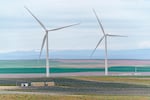
Solar panels and wind turbines work to create clean electric power, at Wheatridge Renewable Energy Facility, May 24, 2022. Portland General Electric partnered with NextEra Energy Resources to build a first-of-its-kind facility that will use an innovative battery technology that supporters are calling a “game changer” for Oregon’s renewable energy transition.
Kristyna Wentz-Graff / OPB
A controversial wind farm that was set to be the largest in Washington has been slashed in half. The proposed project outside the Tri-Cities has raised concerns about endangered hawks and viewsheds. However, the project developer said these new restrictions could be bad for renewable energy development in the state.
Scout Clean Energy, developers of the Horse Heaven Hills Clean Energy Center, hoped to build hundreds of wind turbines, potentially 50 feet taller than Seattle's Space Needle. The wind farm would be built along 24 miles of ridge lines in southeastern Washington. Scout Clean Energy also has plans to build solar arrays and battery storage at the site.
However, during a meeting Wednesday, the state's Energy Facility Site Evaluation Council, or EFSEC, limited where turbines could be built within the project site. The goal would be to curb concerns for nearby ferruginous hawk nests and wildlife corridors.
EFSEC councilmember Lenny Young said prohibiting development east of Straub Canyon would have limited the harm to traditional cultural properties; however, the council denied that restriction.
“The dominant driver for this, for me, is to address the significant, unmitigable impacts to traditional cultural properties,” Young said.
In documents submitted to the council, the project developers called the restrictions arbitrary.
According to a letter sent to the council from Scout Clean Energy President and CEO Michael Rucker, the restrictions “are unsupported by scientific or any other evidence in the record and would render the Project both technically and economically nonviable without substantial amendment to the application.”
The council will recommend whether to approve the renewable energy project. Gov. Jay Inslee will have the ultimate say.
It’s expected the public will be able to comment on the restrictions before the council sends its recommendations to the governor.
Also at the meeting, the council discussed how wind projects could affect aerial firefighting capabilities.
The height of the turbines would likely prevent some aerial firefighting, including the use of drones and helicopters, Washington State Department of Natural Resources leaders told the council.
While the turbines could reach up to 657 feet, most aerial firefighting happens below 500 feet, according to Russ Lane, manager of the DNR Wildland Fire Management Division. Aerial firefighting could be unsafe in the middle of the proposed project.
“The density and spacing of the towers would essentially create a no-fly zone over the entire project area. We would apply an additional ‘safety buffer’ of one-to-two tower-heights around the project to ensure safe separation for aircraft operations,” Lane wrote.
If a water or flame bucket got tangled in a turbine blade, the results could be “catastrophic,” he said.
During the meeting, Amy Moon, EFSEC siting and compliance lead, reported Lane’s thoughts to the council. Fighting fires from the air by dropping water or flame retardant could do more damage to wind projects than the fire, she said.
“These drops come down with the force of gravity and many thousands of pounds of water or retardant that could easily snap off blades and could do other damage to towers,” Moon said.
In addition, Lonnie Click, Benton County Fire District No. 1 Chief, told the council the fire district’s responses would be “nearly exact” to DNR’s responses.
Young raised the concern that fire plans for fighting from the ground should be really well thought out – making up for a lack of ability to fight fires from the air. It’s a problem for all wind projects, he said.
A Washington bill to address these concerns is making its way through the House this session.
Council chair Kathleen Drew said she was concerned about firefighting on the perimeter of the projects. Other wind projects outside Ellensburg saw minimal damage after recent fires burned around the turbines.